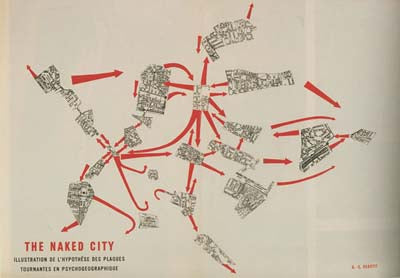Paris, turntable

Luc Sante's excellent new piece for the New York Review of Books places Eric Hazan's The Invention of Paris among Debord and Benjamin in the literature of psychogeography. Calling The Invention of Paris "one of the greatest books about the city anyone has written in decades, towering over a crowded field, passionate and lyrical and sweeping and immediate," Sante compares Hazan's conception of Paris to Debord's iconic The Naked City,
which isolate clusters of blocks and show their subjective connections to their neighbors, or lack thereof, with big red arrows. Hazan notes, for example:
'The Arsenal triangle between the Boulevards Henri-IV and Bourdon-the starting point of Flaubert's Bouvard and Pécuchet, on a bench with the thermometer at 33 degrees C-with its acute angle at the Bastille, and dividing the Saint-Paul quarter from the approaches to the Gare de Lyon.'
The triangle in fact figures in The Naked City, with arrows leading to and from the train station, to St.-Paul, and from the Île St.-Louis, while resolutely ignoring the Bastille. On site you don't need to know its history or its literary pedigree to sense those occult connections and that it is, as Debord put it, a "turntable."
Eric Hazan came to writing late in life, as Sante observes in his review. Still, as the founder of the Parisian publishing house La Fabrique (and as the son of French art-book publisher Fernand Hazan), Eric is the ideal flâneur:
Hazan takes in both the big picture and the minute details, and is attentive to all those nuances of ambiance and demarcation that even today can make a relatively short walk in certain parts of Paris feel like a journey between epochs ... His tour of the arrondissements is never dull, with his lean and pointed prose montaged-in the cinematic sense-with citations chosen for color, depth, and economy from an apparently bottomless well of lore; its dynamic momentum makes it the closest thing yet to Benjamin's imaginary animation.
Visit the New York Review of Books to read the review in full.
